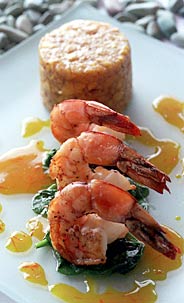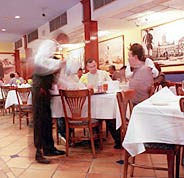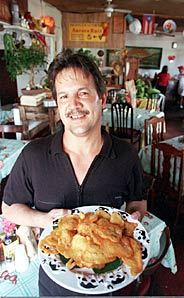|
 |
|
Esta página no está disponible en español. THE NEW YORK TIMESCHOICE TABLES: Eating Mofongos In Style -- Four San Juan RestaurantsBy MARK BITTMAN
March 24, 2002 SAN JUAN has the kind of food I crave, bursting with bold flavors dominated by meat, salt and crunch. The dishes you expect, like crispy pork, salty plantains and infinite variations on the beans-and-rice theme, are as good as they get. And the specialties you may never have tried, like bacalaítos, mofongos and alcapurias, are unforgettable. This is not nouvelle cuisine, thank goodness, and fat-phobic mainlanders will have to loosen up a bit. There are no little heart-healthy signs on the menus, and no assurances that frying is done in canola oil (assume, rather, that it is done in lard). Most meals come with a tiny salad of iceberg lettuce — hey, it's refreshing — and bad tomatoes; unless you count beans, plantains and a variety of starchy roots, you are not going to see much in the way of vegetables. But if you go to the right places, you will eat more than you plan to, enjoy it more than you can imagine, and regret it not at all. This is food with a sense of place, cooking that stubbornly refuses to change, remaining true to its roots, a unique combination of West African, Spanish, Caribbean and American. When I was planning my trip, almost everyone familiar with Puerto Rico knew of a place with memorable fried pork bits, or ham croquettes or goat fricassee. That's a good sign, and those kinds of places are easy to find here. Here are four of the best. Pikayo
Mofongo (mashed plantains) and shrimps with curry sauce at Pikayo. (PHOTO: Laura Magruder/The New York Times) --------------------- Pikayo is a big-city, big-money establishment that looks as if it could be anywhere, a restaurant catering to well-heeled locals, tourists, and the international business community, ideally situated in the Museum of Art. (The restaurant itself features fine local artwork.) The walls are washed with constantly but gently changing colored lights, which at first I found annoying. After a while, however, I grew to like the color shifts, the play of lights on my companions' faces, on the frosted glass that breaks the room up into cozy sections, on the gauze curtains, on the indeterminately colored walls. Almost as much fun is the flat-screen TV over the stainless-steel bar, displaying the kitchen, a cute twist on the open kitchen theme. But if the look is high-class international, much of the food is decidedly Caribbean. Although the chef sometimes forgets where he is — turbot with artichokes and shallots contains no indigenous ingredients — the best food on the stylish plates is either Caribbean-based fusion or just plain down-home, taken to the highest possible level. Shrimp in a guanabana (soursop) sauce with chorizo was a perfect example, the huge shrimp grilled, the sweetness of the fruit countered by the meat's spicy smokiness. I could not get enough of a special of hollowed-out steamed squashlike chayote containing a moist, complex stew of flaked salt cod with okra, eggplant, raw garlic, and lime. My favorite dishes at Pikayo, like these, built directly on traditional creations. Another, pork loin stuffed with chorizo then sliced to showcase the round red center, was sauced with a play on traditional fricassee, using a cheap fortified wine called El Cocinerito (The Little Cook), here accented with rich demi-glace. This was served with rice and beans cooked together in a skillet until slightly crispy. The mofongo — sautéed green plantains mashed with raw garlic and cracklings, then shaped into balls and served with saffron chicken stock — was unmatched here. Desserts were less consistent: hazelnut cake with dulce de leche sauce was super, but a flan made with sweet potatoes was unpleasantly starchy, and coconut sorbet was icy. The service is high level, attentive but unobtrusive. There's a $2 a person water charge, but the water poured is French; most people would consider that a bargain. When a companion complained about the wine-by-the-glass list, she was quickly given her choice of a couple of dozen wines from the list. (One of these, Veigadares 2000, was an Albariño — a white wine from Galicia in Spain — from Adegas Galegas. Priced at $38 a bottle, it was sensational.) Havana's Café
Lunchtime at Havana's Café. (PHOTO: Laura Magruder/The New York Times) --------------------- Leave your inhibitions behind when you enter Havana's Café, in Santurce, the downtown of San Juan. This is a deceptively tame-looking restaurant, with its lovely Cuban blue bar, bright colored walls and molding, cherry wood, quarry tile floor and great black-and-whites of old Havana, and with its older waiters dressed as if this were Broadway in the 50's, with tuxedo vests, ties, collars and pants. But the food here is powerful and bold, traditional peasant food with no holds barred. If you're not in the mood for serious eating, start with one of the first-rate mojitos and you'll soon be there. The menu, which is in Spanish and English, is a big one, and it has more Spanish dishes than most, ranging from the simple sepia (cuttlefish) in garlic sauce (the only dish I tried that was less than wonderful) to duck breast with tarragon and honey; still, it's the Caribbean-accented food that is most appealing. I can personally vouch for the perfectly fried calves' brains, served with lime and, as if they needed it, a little pitcher of nicely browned butter laden with capers. With this I got amarillos — the ubiquitous side dish of sautéed mature plantains, sweet and slightly crunchy — and black beans and white rice, along with some raw onion to put in the beans. At this point I was enamored of mofongo, so I asked for one on the side to taste; it was garlicky and chewy. Masitas, irresistibly crisp-fried pork bits, are served with a pile of smothered onions and a scoop of Moors and Christians, black beans cooked with white rice. The wine list, which mostly draws from Spain, California, and Chile, is admirable and fairly priced. Again I chose an Albariño, this time from Santiago Ruiz ($38); it was fruity, crisp and distinctive. Service here is old-fashioned formal and friendly at the same time; there is a bit of flourish but you would be comfortable in jeans. It's a family-oriented place, and a welcoming one. Desserts are a cut above the island's average; the flan with cheese, a dense, almost layered variation, is extraordinarily rich. El Mesón de Melquiades When every savvy person queried includes the same restaurant on a list of favorites, I go. El Mesón de Melquiades is undeniably a trek from San Juan — it's in Cayey, in the hills in the middle of the island, about 45 minutes from the center of San Juan — but unquestionably worth it. Go for lunch, not only because the last 15 minutes of driving are twisty but also because the scenery is spectacular and, if you like, you can continue south after lunch, heading through the mountains to Puerto Rico's sedate south coast. El Mesón is the quintessential country food shack, a peach-and-white house that would be easy to miss were it not for the crowds. On a pleasant Sunday there are a few hundred people here, eating, standing on a terrace admiring the view, waiting for a table, sipping one of the excellent Tom Collinses or a bright blue drink made with Curaçao, and munching on one of the alcapurias for which Melquiades is known. Alcapurias are egg-roll look-alikes, but the wrapper is made from a dough containing an assortment of cooked and mashed roots; the filling here is of corned beef. Served with a tomato and garlic sauce, they are addictive, as is the rest of the food in this modest but pleasant place, its interior cooled by mountain breezes. After the requisite alcapurias, you might have ham croquettes, bits of smoky ham bound by béchamel and deep-fried so they are crisp outside and incomparably tender inside. (Though the issue is highly debatable, I found these the best croquetas de jamón I had.) Main courses range from the excellent and decidedly down-home fried pork with tostones and white rice to a huge rack of lamb — seven chops in all — with mint sauce and potatoes. There is a wine list, and it isn't a bad one, with some good selections from Spain including a Rioja Alta 904. Service here is friendly, efficient, informal and conducted entirely in Spanish. This is not a cosmopolitan place catering to tourists; the food is plentiful and good, but the overall experience — going beyond what's on the plate — is the attraction. Casita Blanca
Jesús Pérez with cod fritters, or bacalaítos, at Casita Blanca. (PHOTO: Laura Magruder/The New York Times) --------------------- Funky and delightful, Casita Blanca is a neighborhood restaurant that does not make itself known to many tourists. But it's only 10 minutes east of downtown, close to the airport and the Ocean Park beaches, and simple enough to get to by cab or car. Though I had been told the restaurant might have a goat tied up outside its front door, that was not the case on my visit, when a companion and I were greeted by a friendly human and seated at a table on a porch. This is indeed a little white house, with a few rooms to sit in, decorated variously with bunches of plantains on stalks, bird cages, hats, aloe, and old signs, paintings and photographs. White shutters are painted with bright green pine trees; the floors are concrete, the pale green tablecloths held in place by a head of garlic, a liquor bottle filled with flowers, a cruet of herb-steeped vinegar, a can of olive oil and a jug of salsa. It's not a swank joint, but it is a pleasant one, and one where food comes first. As we had our lunch overlooking the sidewalk and a busy transmission repair shop across the way, several passers-by wished us buen provecho, or good appetite. My appetite was better than good after the bacalaítos — supercrisp, salty fried chips of salt cod in batter — were brought to the table while we perused the menu written on a chalkboard. The choices were extensive, and we settled on arroz con calamares, a fried-rice-like preparation that contained bits of squid and pork. It was served, as are all the rice dishes, with a small metal sauce-pan filled with a magnificent stew of kidney beans, roots, greens, cilantro and garlic (these nearly stole the show). Slow-roasted pork was garlicky, salty, tender and delicious, served with white rice, the bean mixture, and of course amarillos. Pastelón, overripe plantains cooked and mashed to form the base for a meat- and-vegetable mixture, was spicy and satisfying. The best dessert here, as at so many other places, is flan, and it is nicely done. They have a local white wine, which regrettably was not available when I was there, and a few types of beer. Service is informal and good-natured, and enough English is spoken to get the menu translated and answer any questions you might have. Bill of Fare Taxis are inexpensive in San Juan, but driving is easy, too. Most streets are clearly marked and even the traffic in the heart of town in the middle of the day isn't too bad (commuting traffic is another story, but you can easily avoid that). Pikayo is the only place where you'll really need a reservation, and you can usually get one within a day or two of the time you want to visit. The restaurants accept all major credit cards, except for Casita Blanca, which takes Visa and MasterCard only. Pikayo, Avenida de Diego 299, Santurce; (787) 721-6194. Open for lunch and dinner Tuesday through Friday, lunch Sunday, dinner Saturday. Closed Monday. There is no smoking except on a small balcony, and reservations are recommended. Valet parking, $10. Dinner for two, with drinks and tip, will run at least $150; there are also tasting menus at $55 (mostly local food) and $85 (more international food). Havana's Café, Calle del Parque 409, Santurce; (787) 725-0888. Open daily for lunch and dinner; reservations are accepted but not necessary except on Fridays and Saturdays. There is a smoking section. On-street parking is easy at night, and there is also a lot across the street. Lunch or dinner for two, with a bottle of wine, about $70. El Mesón de Melquiades, Carretera 15, Ramal 738, Kilometro 0.5, Barrio Culebra Alto, Cayey; (787) 738-4083. Open Friday, Saturday and Sunday only. Be sure to get driving directions from your concierge; once you're on the right road it's easy. No smoking; there are no reservations; you will be given a number if you have to wait for a table. Parking is off the road, and not a problem (as long as you remain aware of the steep hill). Lunch or dinner for two, with wine, ranges from $40 to $80; mine was $70 without stinting. Casita Blanca, Calle Tapia 351, Villa Palmera: (787) 726-5501. Open Monday through Thursday from 11:30 to 7 (note early closing time), Friday and Saturday to 10, Sunday, noon to 5 (buffet lunch only, $12); no reservations. On-street parking (you may have to walk a block or two). There is a smoking section. Lunch or dinner for two, with drinks, $50 at the absolute most.
|

 ---------------------
--------------------- ---------------------
--------------------- ---------------------
---------------------